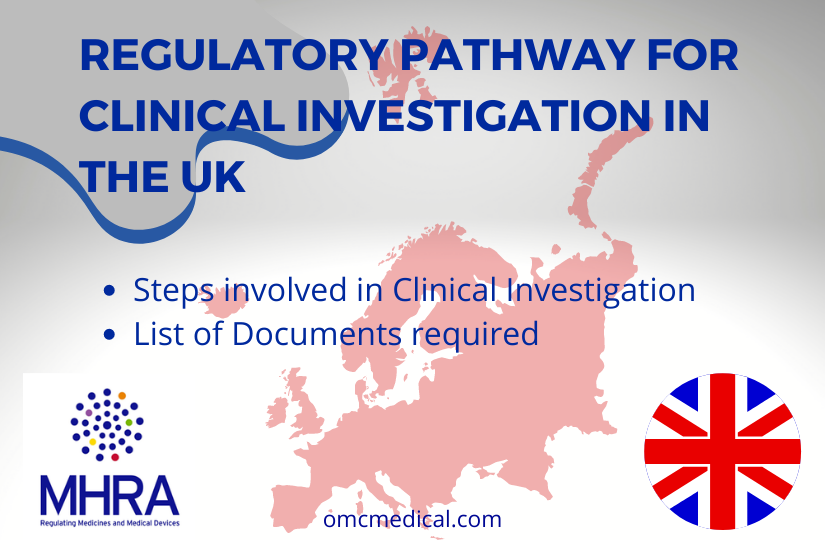Clinical investigation creates a set of clinical data that is crucial to understanding the effectiveness of a medical device. Clinical Investigation is done for devices that are previously UKCA / CE / CE UKNI marked or for research medical devices.
It is governed by a clinical investigation plan with an objective, methodology, and record keeping.
Steps involved in Clinical Investigation in UKCA
Step 1:
Ensure all the information necessary to demonstrate compliance with all the relevant essential requirements is available. Appoint an Authorised representative/Responsible person.
This representative communicates to the Medicines and Healthcare products Regulatory Agency (MHRA) on behalf of Manufacturers.
Step 2:
Please provide the MHRA with advanced notice of your intention to submit a clinical investigation by emailing [email protected] with some basic details about the investigational device, the intended population, the type of study, and the estimated application date.
They conducted in Great Britain must follow UKCA Medical Devices Regulations MDR 2002. Clinical Investigations in Northern Ireland must meet the requirements of the EU MDR and be submitted to MHRA.
Step 3:
Application for a Clinical Investigation is made via Integrated Research Application System (IRAS).
Complete the CI Application form and submit the list of documents. Submission of documents should be in English. If the documents are in other languages, translation into English should be made available. Supported format PDF only.
List of Documents required
• Cover letter on headed paper
• Clinical investigation plan or CIP
• Investigator’s brochure
• Participant information sheet
• Consent form from participants
• CVs of UKCA clinical investigators
• Details of the device
• General Safety and Performance Requirements (GSPR) or Essential requirements checklist
• Report on Risk analysis
• Instructions For Use of a medical device
• Device labels
• Summary of pre-clinical and bench tests.
• List of standards
• Sterilisation validation report (where relevant)
• Software information (where relevant)
• Biological safety assessments of patient contact materials (if any)
• Information on animal tissues (if any)
• Information of any medicine or human blood derivative, or non-viable human tissues and cells incorporated into the device
• Research ethics committee opinion (if available)
Step 4:
Payment of Fees
Devices are categorised according to risk as a Group A or B device: Group A includes class I, IIa, and IIb devices other than implantable/long term invasive. Group B has class IIb implantable/long term invasive, class III, active implantable devices.
MHRA fees and guidance on making a payment for the application of clinical investigation are available on the MHRA website.
Step 5
The review process by MHRA /Assessment procedure.
When the MHRA has validated the documents, within five working days, a response is obtained. It will confirm that the 60-day assessment has started or response to issues.
If issues are raised, the 60-day evaluation will start when MHRA receives a valid response. Day 1 of the 60 days is the first working day that follows the date of receipt of a valid Notification.
Experts will check the safety and performance of your device. The MHRA will write to you if they require further information. A letter will be sent on the 60th day with a decision (‘objection’ or ‘no objection’) if the clinical investigation can be carried out or not.
If any severe events occur during the assessment, they should be reported using the MEDDEV 2.7/3 or MDCG 2020-10/2 Reporting Table.
Step 6
Notification of Amendments (if any)
Once a letter of no objection is received after the review process, you must notify the MHRA of proposed amendments to the investigation. You must wait until another letter of no objection before implementing the changes.
Any changes made to the following must be notified:
- the device under investigation
- study documentation, including the clinical investigation plan
- investigators or investigating institutions
- changes requested by an ethics committee
The following document must be presented for notification of amendments.
- covering letter with:
Reference number allotted by MHRA for the CI and a table with a summary of each proposed change with the reason for the individual changes.
FAQs
Is the procedure the same for Northern Ireland and Great Britain?
The overall procedure remains the same, but the documents required may vary. This is due to the regulations followed in both regions. Northern Ireland follows EU Medical Devices Regulations 2017/745, whereas Great Britain follows UK MDR (Medical Devices Regulations) 2002.
What happens if amendments are not notified to MHRA?
All modifications should be notified to MHRA. However, only some are substantial. Manufacturers/Sponsors must notify else; they are liable to prosecution. More details can be found here.
